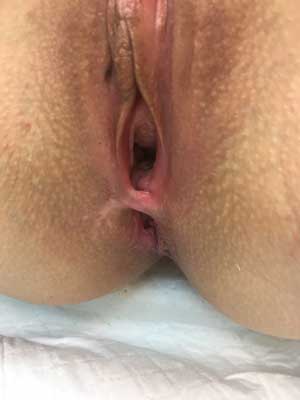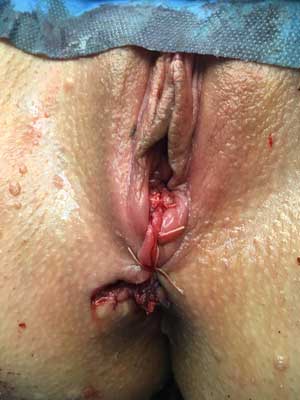*Małgorzata Kołodziejczak1, Przemysław Ciesielski1, 2, Maja Gorajska-Sieńko2
Proctogyneacology – who should treat? A proposed treatment algorithm
Proktoginekologia – kto powinien leczyć? Propozycja algorytmu postępowania
1Warsaw Proctology Centre, Saint Elisabeth Hospital in Warsaw
2Hospital of Our Lady of Perpetual Help in Wołomin
Streszczenie
Proktoginekologia zajmuje się chorobami zarówno kanału odbytu, mięśni zwieraczy, odbytnicy, przegrody odbytniczo-pochwowej, jak i narządu rodnego u kobiet. Choroby te mogą dotyczyć rozluźnienia struktur dna miednicy i przegrody odbytniczo-pochwowej (wypadanie odbytnicy, pochwy, macicy, enterocele, rektocele), mogą być wynikiem uszkodzeń okołoporodowych, w tym urazów zwieraczy, przetok odbytniczo-pochwowych, endometriozy okolicy zwieraczy i przegrody odbytniczo-pochwowej, proktologicznych chorób zapalnych u ciężarnych, a także popromiennych uszkodzeń odbytnicy związanych z leczeniem nowotworów narządu rodnego. Nie ma ustalonych zasad postępowania dotyczących tematu, jaki specjalista powinien te pacjentki operować. W artykule autorzy podjęli próbę usystematyzowania tego zagadnienia w postaci algorytmu. Kluczowym wydaje się być interdyscyplinarny dialog skutkujący rozwojem zawodowym nas, lekarzy, oraz przede wszystkim sukcesem terapeutycznym i zmniejszeniem ryzyka powikłań pooperacyjnych.
Summary
Proctogyneacology deals with conditions involving the anal canal, anal sphincter muscles, rectum, rectovaginal septum, and the female reproductive tract. They may be due to sagging of the pelvic floor and the rectovaginal septum (rectal, vaginal or uterine prolapse, enterocele and rectocele), perinatal injury, including sphincter damage, rectovaginal fistulas, endometriosis with anal sphincter and rectovaginal septum involvement, proctological inflammatory diseases in pregnancy, as well as radiation-induced rectal damage after gynaecological cancer treatment. There are no set guidelines defining which specialist should operate on these patients. We attempted to systematise this issue in the form of an algorithm. An interdisciplinary dialogue allowing for our professional development and, most of all, therapeutic success and reduced risk of postoperative complications, seems to be crucial.

Introduction
Proctogyneacological conditions are those involving the anal canal, anal sphincter muscles, rectum, rectovaginal septum, as well as the female reproductive tract. They may be due to sagging of the pelvic floor and the rectovaginal septum (rectal, vaginal or uterine prolapse, enterocele and rectocele), perinatal or other type of injury, including sphincter damage, rectovaginal fistulas, endometriosis with anal sphincter and rectovaginal septum involvement, proctological inflammatory diseases in pregnancy, as well as radiation-induced rectal damage after gynaecological cancer treatment. There are no uniform guidelines defining which specialist should treat patients on the borderline of these two specialties. The treatment approach, as well as the role of gynaecologist and proctologist differ in each of these conditions. Personal experience in performing specific, often technically complex surgical procedures, is undoubtedly crucial.
In this paper, we discuss the most common clinical situations that may require a cooperation between a gynaecologist and a proctologist. We also attempted to systematise indications for surgeries performed by these two specialists, bearing in mind that this is a significant simplification of the problem and that operator’s experience in performing a given procedure is the main decisive factor, whereas speciality (gynaecology or surgery) is of secondary importance.
These are:
– peripartum anal sphincter damage often coexisting with vaginal ectasia,
– rectovaginal fistula (postpartum, radiation-induced or other),
– conditions associated with sagging of the pelvic floor and the rectovaginal septum (rectal, vaginal or uterine prolapse, enterocele and rectocele),
– endometriosis,
– proctological conditions in pregnancy and the perinatal period.
Much depends on the experience of a particular doctor in the treatment of the above diseases, hence the scope of competence may vary.
Peripartum anal sphincter damage
Perineal tear occurs in 2-6% of patients having vaginal delivery (1). Less than 0.5% of all births are complicated by grade III and IV perineal tear (2), with only a small proportion of patients reporting symptoms of incontinence. It may be therefore concluded that these injuries are properly managed on an emergency basis in most cases. In the case of third-degree tear, i.e. damage involving the anal sphincter, but with preserved rectal wall continuity, emergency suturing of the anal sphincter is most often performed by a gynaecologist-obstetrician. For medical and legal reasons, this should be the most experienced doctor in the team on duty or a less experienced doctor assisted by the duty chief. In the case of fourth-degree perineal tear, which is a very serious complication involving damage to the rectal wall, it is advisable that the surgery is performed by a surgeon if possible. If the injury was missed during labour (occult defect accounting for 3% to up to 35% of cases in literature reports) (3) or wound dehiscence occurred, repair should be delayed by 4-6 months until inflammation in the adjacent tissues resolves. In such cases, the procedure should be preceded by diagnosis in a reference colorectal centre (imaging and functional diagnosis). Elective sphincter repair should be performed by a proctological surgeon experienced in this type of surgeries. If the procedure is combined with posterior vaginal wall repair, multidisciplinary surgeries (performed by a surgeon and a gynaecologist), often combined with levatorplasty, are the best approach. This type of surgery may be performed by an experienced coloproctologist (fig. 1, 2).

Fig. 1. Peripartum sphincter damage

Fig. 2. An image after sphincter repair
A rectovaginal fistula
Powyżej zamieściliśmy fragment artykułu, do którego możesz uzyskać pełny dostęp.
Mam kod dostępu
- Aby uzyskać płatny dostęp do pełnej treści powyższego artykułu albo wszystkich artykułów (w zależności od wybranej opcji), należy wprowadzić kod.
- Wprowadzając kod, akceptują Państwo treść Regulaminu oraz potwierdzają zapoznanie się z nim.
- Aby kupić kod proszę skorzystać z jednej z poniższych opcji.
Opcja #1
29 zł
Wybieram
- dostęp do tego artykułu
- dostęp na 7 dni
uzyskany kod musi być wprowadzony na stronie artykułu, do którego został wykupiony
Opcja #2
69 zł
Wybieram
- dostęp do tego i pozostałych ponad 7000 artykułów
- dostęp na 30 dni
- najpopularniejsza opcja
Opcja #3
129 zł
Wybieram
- dostęp do tego i pozostałych ponad 7000 artykułów
- dostęp na 90 dni
- oszczędzasz 78 zł
Piśmiennictwo
1. Chin K: Obstetrics and fecal incontinence. Clin Colon Rectal Surg 2014; 27(3): 110-112.
2. Djaković I, Ejubović E, Bolanča I et al.: Third and Fourth Degree Perineal Tear in Four-Year Period at Sestre Milosrdnice University Hospital Center, Zagreb, Croatia. Open Access Maced J Med Sci 2018; 6(6): 1067-1071.
3. Kołodziejczak M: Okołoporodowe uszkodzenia zwieraczy odbytu – badanie prospektywne. Rozprawa habilitacyjna. Akademia Medyczna w Warszawie 2006.
4. Kołodziejczak M: Leczenie chorób proktologicznych w okresie ciąży i porodu. Wydawnictwo Borgis, Warszawa 2011: 91.
5. Bhandarkar DS: Laparoscopic rectopexy for complete rectal prolapse: mesh, no mesh or a ventral mesh? J Minim Access Surg 2014; 10(1): 1-3.
6. Beck DE, Allen NL: Rectocele. Clin Colon Rectal Surg 2010; 23(2): 90-98.
7. Lehur PA, Stuto A, Fantoli M et al.: Outcomes of stapled transanal rectal resection vs. biofeedback for the treatment of outlet obstruction associated with rectal intussusception and rectocele: a multicenter, randomized, controlled trial [published correction appears]. Dis Colon Rectum 2008; 51(11): 1739. Narisetty, Prashanty [corrected to Narisetty, Prashanthi]. Dis Colon Rectum 2008; 51(11): 1611-1618.
8. Paraiso MFR, Falcone T, Walters MD: Laparoscopic surgery for enterocele, vaginal apex prolapse and rectocele. Int Urogynecol J 1997; 8: 146-152.



